#Lazarus species
Text
That's so cool! And they found a few of them, and they're now growing seedlings in greenhouses for eventual replanting!
Quercus tardifolia is a relic species leftover from when the climate was much cooler and wetter in the past, and can only really live in a few high-elevation spots in Texas. It's definitely still at risk of extinction due to increasing heat and drought caused by climate change, but the discovery means this species still has a chance.
#oak#oak trees#Quercus#Quercus tardifolia#Lazarus species#endangered species#extinction#trees#plants#botany#nature#climate change#global warming
4K notes
·
View notes
Text

[ Pepijn Kamminga holds the only Attenborough's long-beaked echidna museum specimen in the world. ]
"Until now, the only evidence that this particular species 'zaglossus attenboroughi' existed was a decades-old museum specimen of a dead animal.
"I was euphoric, the whole team was euphoric," Dr James Kempton told BBC News of the moment he spotted the Attenborough echidna in camera trap footage.
"I'm not joking when I say it came down to the very last SD card that we looked at, from the very last camera that we collected, on the very last day of our expedition."
Dr Kempton headed a multi-national team on the month-long expedition traversing previously unexplored stretches of the Cyclops Mountains, a rugged rainforest habitat more than 2,000m (6,561ft) above sea level.
In addition to finding Attenborough's "lost echidna" the expedition discovered new species of insects and frogs, and observed healthy populations of tree kangaroo and birds of paradise.
Aside from the duck-billed platypus, the echidna is the only mammal that lay eggs. Of the four echidna species three have long beaks, with the Attenborough echidna, and the western echidna considered critically endangered.
Previous expeditions to the Cyclops Mountains had uncovered signs, such as 'nose pokes' in the ground, that the Attenborough echidna was still living there.
But they were unable to access the highest reaches of the mountains and provide definitive proof of their existence.
That has meant that for the last 62 years the only evidence that Attenborough echidna ever existed has been a specimen kept under high security in the Treasure Room of Naturalis, the natural history museum of the Netherlands."
- Excerpt from "First ever images prove 'lost echidna' not extinct" by Jonah Fisher and Charlie Northcott.
43 notes
·
View notes
Text
Bird Feared Extinct Spotted First Time After 24 Years
Oh snap??? 👀
0 notes
Text
Ghost Cores are Dionesium
So! I while ago, I saw a Post about Danny and the Court of Owls, and one suggestion in the comments basically said, "What if Dionesium, the stuff they use to bring back the dead, is just Ghost Cores?"
And that got me thinking. Lazarus Pits are just Dionesium Infused Water, so how would they be created if Dionesium is a Ghosts Core? Well they way I see it, Lazarus Pits can only be formed in 2 Ways.
The first way is for a large number of Ghosts to be Ended at the same time, with their shattered Cores piling up and dissolving into Water.
The other way, if for an Ancient to Die. The Ancients are practically God's, and as such their Cores are immense in Power. When an Ancient dies, and their Core is left to dissolve in the Human Realm, it forms a Lazarus Pit in the exact same way it would take hundreds of normal Cores to do so.
Where am I going with this?
Well, isn't there a Giant Lazarus Pit under Gotham? The Batcave even has one, doesn't it?
The reason Gotham is so cursed isn't because Lady Gotham likes to collect Curses, or because her Ectoplasm is corrupted, it's because she isn't there to stop them anymore.
Lady Gotham is Dead.
Her Core sank deep into the Earth, forming a Lazarus Pit under the entire City, but thankfully far away from her People. She died, and only the fact that she is a Conceptual spirit saved a piece of her Consciousness. She represents a City, she can only fully be killed if the entire City is leveled. That doesn't mean she is still alive however, just that the barest sliver of her mind is hanging on by a Thread.
This is how Gotham possessed Batman that one time, it was her base instincts saving one of her precious children.
If you want her to be a little more cognizant, maybe she is just severely Injured? Her Core is cracked to the edge of shattering and she desperately needs help.
She she calls out to whoever could save her, and a certain Ghost Boy hears her cry for help?
#Dpxdc#Dp x dc#Dcxdp#Dc x dp#Danny Phantom#Dc#Dcu#Lady Gotham#Lady Gotham is Dead#Dionesium is made of Ghost Cores#Ghost Cores are made of Dionesium#Lady Gotham died and her Core formed the Lazarus Pit under Gotham City#I wonder how the League's Pit was formed? Was it a Dead Ancient or a large number of Ended Ghosts?#Either way they died Mad#That's where Pit Madness came from#What would the Court of Owls do when they find out that there is an entire Species that is made of that Immortality Metal they want so much#Maybe a story for another Prompt?#Also#Lady Gotham had been like this for a while#But it's only gotten as bad as it is now recently#Everybody in the city can feel that something is off#They don't know why#But the older generations know that it's been getting worse for years now and it's finally reaching a head#Like the climax of a story decades in the making is about to unfold#But they have no idea what that means to them#Thoughts?
594 notes
·
View notes
Text
I truly think Jason, while underage goes to the oblivion bar to get shitfaced when he knows Bruce is tracking him. I wish magic boy was shown to be more magic.

ignore the background idk what I'm going. I do know that Bobo is going to fucking destroy everyone at that table.
#jason todd#bobo T. chimpanzee#john constantine#Fucking Santa???#after santa fucking dies does yj show up to their meetings and is like what the fuck are YOU🫵 doing here#i think it would be funny as the bat with inate magic in gotham he has to round up endangered magical species and get them back to their#natural habitat without damian finding out griffins / dragons exist and are easily found#unfortuanetly many magic animals fucking hate him bc lazarus pit (death/poison vibes) or all blades (distinctly antimagic)#like animal control except all the animals are huge and want him dead
50 notes
·
View notes
Note
What are your controversial opinions on animal husbandry?
Whether an animal has been domesticated is irrelevant when you're asking if it makes a good companion animal. A cattle bull is an awful pet. A boar pig is an awful pet. A Tibetan mastiff is an awful pet. A game rooster is (often, not always) an awful pet. Meanwhile stick insects, corn snakes, hedgehogs, and California quail are all wild animals that make fantastic pets.
No animal should be outright illegal to keep, but you also shouldn't be able to walk into a pet store and just buy any animal. There should be a licensing system for all animal husbandry.
Private ownership of dangerous exotics can be a good thing within this licensing system. It's what we have here in Denmark (to a degree; a lot of animals still don't require a license, unfortunately), which has led to the formation of Krokodille Zoo, a private zoo that contributes significantly to international crocodilian conservation.
If someone wants an elephant, have proven that they have the funds, facilities, and expertise to take care of an elephant, and there is a surplus elephant in the zoo system, they should be able to get a license to take in that elephant, regardless of if they're a private person or a public institution. I understand where (E)AZA's decision with regards to surplus animals comes from, but that doesn't mean I don't think it sucks ass that they just euthanize all surplus animals. Those animals could still be ambassadors without being part of an EEP or SSP or [insert other captive breeding program].
Also private people should be able to contribute to captive breeding programs when possible. Lord knows, the tarantula community cares more about the fate of P. metallica than EAZA ever will...
#animal welfare#ask#the only arthropod that gets literally any attention from AZA beyond a single SSP document/guideline is fucking.... lord howe island sticks#i love them don't get me wrong#but we all know they only get the attention because they're a lazarus species
174 notes
·
View notes
Text

judas baby! first time ive been able to draw them w/ lazarus and gabriel and be satisfied w/ it. judas is the youngest out of the three (14) and still doesnt much like the taste of blood so any time fae need it ezekiel (faer mom) mixes it in w/ some cranberry juice to make it go down easier. judas has been the fussiest out of ezekiel's kids to get used to drinking blood also and isnt very good at being a nightmare yet bc they favor mischief over fear.
#cliffnotes/.txt#cliff png#still working it out indefinitely but decided to call these guys' species of monster nightmares#they feed on blood and feelings of fear#didnt wanna do a straight up vampire thing#also their teeth are bigger than like traditional vampire canines#theyre made better for tearing to consume more so their eating is less clean#gabe wont feed from her on/off gf but lazarus has no issues tearing up pulse's throat and getting soaking the tops of his shirts in blood#they do a good job of cleaning up after themself tho#need to work out this whole ocverse but who is here but me#also using judas to learn/get used to fae pronouns#want to try giving some of my ocs neopronouns
12 notes
·
View notes
Photo



ive been having fun thinking about how my ocs would like the new pokemon
#ibis art#pokemon spoilers#pokemon sv spoilers#JUST IN CASE it's just new pokes and i'm sure everyone's seen these already but still#as a courtesy#ANYWAY#pokemon#lazarus bensi#sal cereza#john doe#underbelly#i named my capsakid clump as in my son clump who has every disease bc that thing is UGLY i LOVE it#and then it evolved and i LOVE IT EVEN MORE#the way everyone was about dracovish is how i am about scovillain#also every member of the species is named clump to me#it's so ugly it wants you dead it has insatiable bloodlust I LOVE IT#my awful terrible son. i kiss him on the nose. and the other nose too
18 notes
·
View notes
Text
Continued from here.
The smug grin remained painted all over Raphael's features as Lazarus approached him. He didn't dare make a move just yet for someone who wasn't afraid to take what he wanted. No, this time he wanted Laz to do that himself since Raph firmly believed the elder dragon was in love with him. And why wouldn't he be? He was the epitome of perfection. "I don't believe that for a second," he tsked. "So go on then, Lazarus." He leaned in a little closer. "Take what you want from me. I know you've been dying for this."

@ashandblcod
10 notes
·
View notes
Text
hi i’m hyperfixating on lazarus species now. so i might make one or two or ten thousand posts about them because they are so cool
#it’s like#you THOUGHT they were dead#BUT THEYRE ALIVE!!! HOW COOL IS THAT!!! THEYRE FUCKING ALIVE!!!!!!!#they’re living they’re still kicking despite everything#i will protect lazarus species with my life they’re everything to me#writing in my diary 📔
2 notes
·
View notes
Text
Me @ DC: I am taking Ra's al Ghul away from y'all none of you understand his crazy.
Me @ Ra's al Ghul: One Bad Day: Except for you, you can stay.
#REPEAT AFTER ME#HE IS NOT JUST A FUCKING CULT LEADER WITH A BUNCH OF FUCKING ASSASSINS AT HIS DISPOSAL#Like yeah that's part of who he is. But far more integral is the fact that he is like 700 years old and has outlived almost everything#He has witnessed firsthand the extinction of so many species. He is watching the lands he loved grow barren and die from exploitation.#And he KNOWS humanity itself is both responsible for this mass extinction and that it is approaching one of its own.#What so many people get wrong is that they assume Ra's is in this because of power or because he's just pure evil or something.#an integral part of his character is that he cares so deeply about life just like Bruce does. they just go about it differently#Ra's is an eco-terrorist and a utilitarian. he would take the life of one billionaire to potentially save thousands of lives down the line.#he does bad things in service of a greater good. that doesn't mean the bad things he does are justified but they have a reason behind them#HE IS NOT JUST A CULT LEADER! HE IS NOT JUST SOME OLD MAN WHO TOOK A FEW TOO MANY DIPS IN THE LAZARUS PIT!#he's a foil to Bruce and a damn good one. I hate when people take that away from him because it makes both of their characters so much bett
0 notes
Photo

[ A dusky tetraka photographed by John C. Mittermeier. ]
“Dusky Tetraka, a small olive and yellow-throated bird that hops around on the ground and has eluded ornithologists for 24 years, was rediscovered by an expedition team searching the tropical forests of northeastern Madagascar. The expedition team, led by The Peregrine Fund’s Madagascar Program, found the species in two different remote sites: one on the Masoala peninsula in late December 2022 and another near Andapa in January this year. The last documented sighting of Dusky Tetraka was in 1999, making it one of the top 10 most wanted lost birds by the Search for Lost Birds, a collaboration between Re:wild, American Bird Conservancy and BirdLife International.
“Now that we’ve found Dusky Tetraka and better understand the habitat it lives in, we can look for it in other parts of Madagascar, and learn important information about its ecology and biology,” said Lily-Arison Rene de Roland, Madagascar Program director for The Peregrine Fund, and expedition leader. “There is a lot of biodiversity still to discover in Madagascar.””
- Excerpt from “Found: Mysterious songbird rediscovered in Madagascar after eluding scientists for 24 years” via BirdLife International.
58 notes
·
View notes
Text
Batman opened the door, catching the falling body that had come out of the tube. Glowing green Lazarus water flowed around his feet, but he didn’t care. He gently laid the boy onto the ground, listening for breathing sounds. But he wasn’t even sure if his species could breathe. The boy was no older than Tim, with stark-white hair, and pale green skin. The boy wasn’t human, that was for sure, but as to what species he was, Batman had no clue. The teenager hadn’t even opened his eyes since being removed from the tube.
The Lazarus water didn’t smell quite like the pits he was used to. The water smelled cleaner, stronger. Less like battery acid and more like a strong-scented cleaner that he couldn’t give a name to.
He grasped the boy by the shoulders as he picked him up bridal style. He needed to take the boy to the cave, and figure out if he was even alive. A regular hospital wouldn’t be able to do anything for him.
“Batman, we’ve apprehended the last of the men in white suits.” Red Robin said over the comms.
“Good,” His voice was gruff, “Make sure they don’t escape before police arrive.”
Tim didn’t bother saying anything else to him. Neither of them were in the mood for jokes. Not after what they had seen tonight. They had stumbled across a lab in Gotham in an abandoned warehouse. They had thought that it was a Joker hideout when they first arrived, but they had quickly found out that wasn’t the case. After they had began to investigate, they had found corpses of many people that had been thrown into a pit. The bodies had evidence of vivisection, torture, and experimentation. The bodies had ranged from children to adults, but the results were all the same. They were all dead.
They had found tubes like the ones used at Cadmus. They held a few humanoid-species, but most of them looked like they were in varying stages of death. The only tube that looked like it held someone living had been the teenage boy he now held in his arms.
The worst thing about all of this were that they had no idea what this place was, what they were doing, or why they were in Gotham. They had stumbled in by mistake.
He had a lot of work to do.
“No survivors.” Nightwing’s voice sounded. Not even Dick was in a good mood anymore, and he had been joking around for the last few hours.
Batman looked down at the boy in his arms. The boy hadn’t stirred once, hadn’t moved, and hadn’t breathed. He might be carrying a corpse for all he knew.
“And the files?” He prompted.
“Downloading.” Red Robin’s voice was grim. “You’re not going to like it.”
He didn’t like anything about this situation already. How could it get any worse?
“From what I can tell from skimming through the files,” Red Robin continued, “They were experimenting with people’s souls. They killed all of these people because they wanted to catch their ghost.”
“Hrrn.” He looked away from the teenager in his arms. Maybe he didn’t have a corpse in his arms—but a ghost. A ghost of a teenager he failed to save.
What if it had been Tim lying in his arms? Dick? Jason? Damian? Did this teenager have parents before he died, or were his parents in the pit?
The boy stirred, whipping Bruce’s attention back to him. The boy moaned in pain, starting to writhe in his arms.
“You’re safe now.” He said to the boy. “You’re saved.”
“Nnnngh.” The boy opened Lazarus green eyes to look at him. The eyes were hazy, as if exhaustion plagued them. “Batman?”
“They won’t hurt you ever again.” He promised.
“Where is my sister?” The boy asked. “They took her.”
Dick’s words played on repeat in his mind. No survivors. But the boy didn’t need to know that. Not yet.
“We’re still searching the base. She’ll be here somewhere.” He lied.
The boy closed his eyes, letting out a deep sigh. But even with Bruce watching him, the boy did not breathe. Maybe he didn’t need to anymore. Tears leaked down the boy’s cheeks, as if he knew Bruce’s lie.
#dp x dc#dp x dc au#dp x dc writing prompt#dp dc crossover#dp x dc fanfic#dp x dc prompt#danny phantom#danny phantom crossover#dp x dc crossover#dp crossover#dpxdc prompts#dpxdc#dcxdp#dc x dp au#giw#ghost investigation ward#batman
4K notes
·
View notes
Text
I recently found out a show I liked is 10 years old now so to not be the oldest thing on this blog I'm talking coelacanths for Wet Beast Wednesday. Coelacanths are rare fish famed for being living fossils. While that term is highly misleading, it is true that coelacanths are among the only remaining lobe-fined fish and were thought to have gone extinct millions of years ago before being rediscovered in modern times.
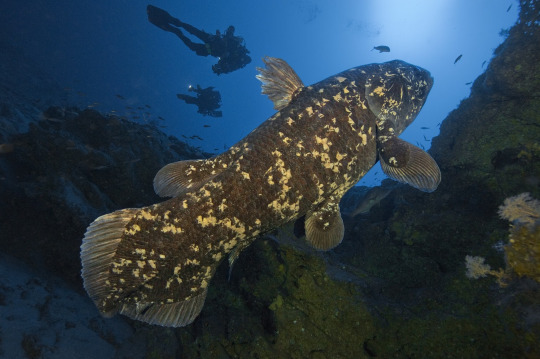
(image id: a wild coelacanth. It is a large, mostly grey fish with splotches of yellowish scales. Its fins are attached to fleshy lobes. It is seen from the side, facing the top right corner of the picture)
Coelacanth fossils had been known since the 1800s and they were believed to have gone extinct in the late Cretaceous period. That was until December 1938, when a museum curator named Marjorie Courtenay-Latimer was informed of an unusual specimen that had been pulled in by local fishermen. After being unable to identify the fish, she contacted a friend, ichthyologist J. L. B. Smith, who told her to preserve the specimen until he could examine it. Upon examining it early next year, he realized it was indeed a coelacanth, confirming that they had survived, undetected, for 66 million years. Note that fishermen living in coelacanth territory were already aware of the fish before they were formally described by science. Coelacanths are among the most famous examples of a lazarus taxon. This term, in the context of ecology and conservation, means a species or population that is believed to have gone extinct but is later discovered to still be alive. While coelacanths are among the oldest living lazarus taxa, they aren't the oldest. They are beaten out by a genus of fly (100 million years old) and a type of mollusk (over 300 million years old).

(image: a coelacanth fossil. It is a dark brown imprint of a coelacanth on white rock. Its skeleton is visible in the imprint)
Coelacanths are one of only two surviving groups of lobe-finned fish along with the lungfishes. Lobe-finned fish are bony fish notable for their fins being attached to muscular lobes. By contrast, ray-finned fish (AKA pretty much every fish you've ever heard of that isn't a shark) have their fins attached directly to the body. That may not sound like a big difference, but it actually is. The lobes of lobe-finned fish eventually evolved into the first vertebrate limbs. That makes lobe-finned fish the ancestors of all reptiles, amphibians, and mammals, including you. In fact, you are more closely related to a coelacanth than a coelacanth is to a tuna. Coelacanths were thought to be the closest living link to tetrapods, but genetic testing has shown that lungfish are actually closer to the ancestor of tetrapods.
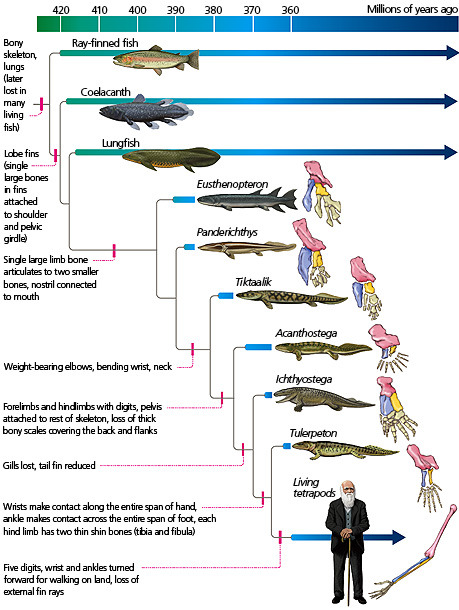
(image id: a scientific diagram depicting the taxonomic relationships of early lobe-finned fish showing their evolution to proto-tetrapods like Tiktaalik and Ichthyostega, to true tetrapods. Source)
There are two known living coelacanth species: the west Indian ocean coelacanth (Latimeria chalumnae) and the Indonesian coelacanth (L. menadoensis). Both are very large fish, capable of exceeding 2 m (6.6 ft) in length and 90 kg (200 lbs). Their wikipedia page describes them as "plump", which seems a little judgmental to me. Their tails are unique, consisting of two lobes above and below the end of the tail, which has its own fin. Their scales are very hard and thick, acting like armor. The mouth is small, but a hinge in its skull, not found in any other animal, allows the mouth to open extremely wide for its size. In addition, they lack a maxilla (upper jawbone), instead using specialized tissue in its place. They lack backbones, instead having an oil-filled notochord that serve the same function. The presence of a notochord is the key characteristic of being a chordate, but most vertebrates only have one in embryo, after which it is replaced by a backbone. Instead of a swim bladder, coelacanths have a vestigial lung filled with fatty tissue that serves the same purpose. In addition to the lung, another fatty organ also helps control buoyancy. The fatty organ is large enough that it forced the kidneys to move backwards and fuse into one organ. Coelacanths have tiny brains. Only about 15% of the skull cavity is filled by the brain, the rest is filled with fat.

(image id: a coalacanth. It is similar to the one on the above image, but this one is blue in color and the head is seen more clearly, showing an open mouth and large eye)
One of the reasons it took so long for coelacanths to be rediscovered is their habitat. They prefer to live in deeper waters in the twilight zone, between 150 and 250 meters deep. They are also nocturnal and spend the day either in underwater caves or swimming down into deeper water. They typically stay in deeper water or caves during the day as colder water keeps their metabolism low and conserves energy. While they do not appear to be social animals, coelacanths are tolerant of each other's presence and the caves they stay in may be packed to the brim during the day. Coelacanths are all about conserving energy even when looking for food. They are drift feeders, moving slowly with the currents and eating whatever they come across. Their diet primarily consists of fish and squid. Not much is known about how they catch their prey, but they are capable of rapid bursts of speed that may be used to catch prey and is definitely used to escape predators. They are believed to be capable of electroreception, which is likely used to locate prey and avoid obstacles. Coelacanths swim differently than other fish. They use their lobe fins like limbs to stabilize their movements as they drift. This means that while coelacanths are slow, they are very maneuverable. Some have even been seen swimming upside-down or with their heads pointed down.
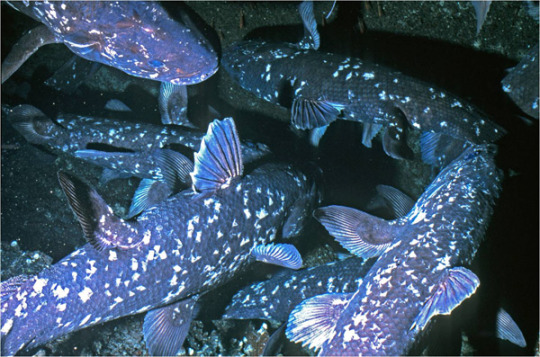
(image: an underwater cave wilt multiple coelacanths residing in it. 5 are clearly visible, with the fins of others showing from offscreen)
Coelacanths are a vary race example of bony fish that give live birth. They are ovoviviparous, meaning the egg is retained and hatches inside the mother. Gestation can take between 2 and 5 years (estimates differ) and multiple offspring are born at a time. It is possible that females may only mate with a single male at a time, though this is not confirmed. Coelacanths can live over 100 years and do not reach full maturity until age 55. This very slow reproduction and maturation rate likely contributes to the rarity of the fish.

(image: a juvenile coelacanth. Its body shape is the same as those of adults, but with proportionately larger fins. There are green laser beams shining on it. These are used by submersibles to calculate the size of animals and objects)
Coelacanths are often described as living fossils. This term refers to species that are still similar to their ancient ancestors. The term is losing favor amongst biologists due to how misleading it can be. The term os often understood to mean that modern species are exactly the same as ancient ones. This is not the case. Living coelacanth are now known to be different than those who existed during the Cretaceous, let alone the older fossil species. Living fossils often live in very stable environments that result in low selective pressure, but they are still evolving, just slower.
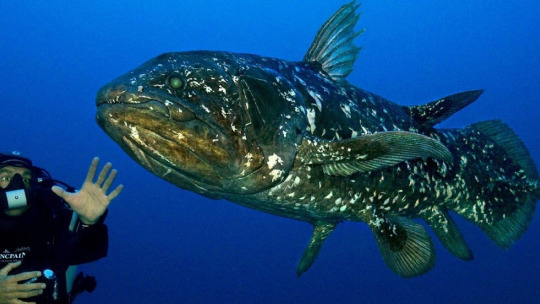
(image: a coelacanth swimming next to a SCUBA diver)
Because of the rarity of coelacanths, it's hard to figure out what conservation needs they have. The IUCN currently classifies the west Indian ocean coelacanth as critically endangered (with an estimated population of less than 500) and the Indonesian coelacanth as vulnerable. Their main threat is bycatch, when they are caught in nets intended for other species. They aren't fished commercially as their meat is very unappetizing, but getting caught in nets is still very dangerous and their slow reproduction and maturation means that it is long and difficult to replace population losses. There is an international organization, the Coelacanth Conservation Council, dedicated to coelacanth conservation and preservation.
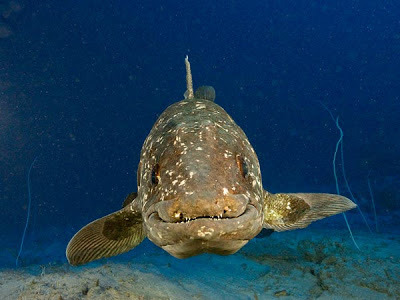
(image: a coelacanth facing the camera. The shape of its mouth makes it look as though it is smiling)
#wet beast wednesday#coelacanth#marine biology#biology#zoology#ecology#animal facts#fish#fishblr#old man fish#lobe-finned fish#sarcopterygii
1K notes
·
View notes
Text
I've been doing a lot of volunteer fieldwork with these guys recently so I thought I might as well do an infodump about them here.
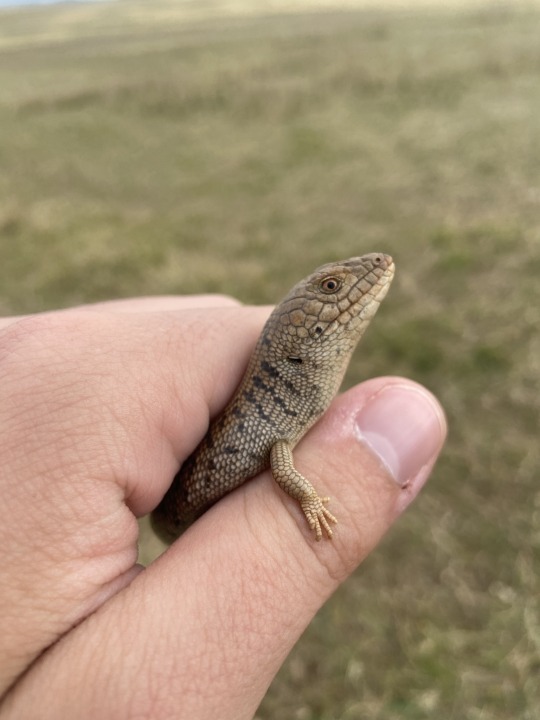
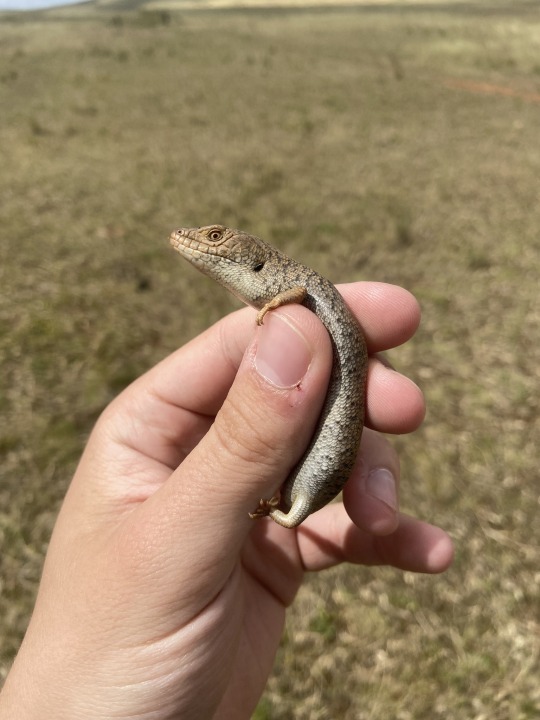
The pygmy bluetongue skink (Tiliqua adelaidensis) is one of the most unique and unusual members of the Tiliqua genus, which includes the true bluetongues as well as the sleepy lizard/shingleback. However, the pygmy bluetongue actually lacks the blue tongue the group is named after, having a pink tongue instead! As its scientific name suggests, it is quite a range restricted species, being found only in open grasslands north of Adelaide, South Australia, as far north as Peterborough. Historically they ranged more extensively across the Adelaide Plains, as far south as Marion, but due to the destruction of suitable habitat they now occur no further south than Kapunda.
While most bluetongues are notable for their large size amongst skinks, with several species regularly exceeding 30 cm in length, the pygmy bluey lives up to its name by measuring a measly average of 9 cm long from snout to vent. This is actually still a fair size compared to the average skink, but it's miniscule by bluetongue standards. Even more notable than their size however are their habits, for they are the only species of lizard that is specialised to live exclusively in old spider burrows! The burrows of both trapdoor and wolf spiders are used, but trapdoor burrows are preferred in most instances.

Pygmy bluetongues spend the majority of their lives within these spider burrows, leaving only to defecate, seek out mates and disperse. The average length of time a lizard spends in a particular burrow is highly dependant on the individual - some are sedentary and spend many years within a single burrow, while others will move around fairly frequently. As well as places to shelter and raise their young (they have parental care, it's very cute), pygmy bluetongues also use the burrows as ambush sites, waiting at the top for suitable prey, usually a mid-sized arthropod, to stray close enough for them to quickly dart out and drag them into the depths.
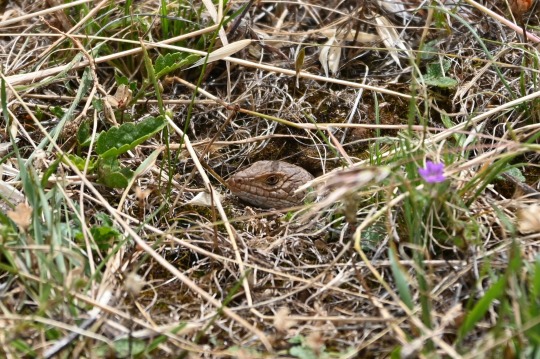
but here's the ambusher
The chief natural predators of pygmy bluetongues are raptors and brown snakes, and sheltering in the burrow is the main defence against both of these threats. Their burrows are often wide enough for a brown snake to enter, but not wide enough for them to open their mouths in - this means all the brown snake usually gets by pursuing a sheltering pygmy is an angry lizard attacking its face, forcing it to retreat.
The lazy lifestyle of the burrow-stealing pygmy bluetongues is certainly unique, and also explains why they have been such an elusive species since they were first discovered by Western scientists in the 1860s. Rarely seen or collected, their habit of inhabiting spider burrows remained undiscovered for the longest time, and by the 1960s they had become so hard to find that they were believed to be extinct. That was until, in 1992, a pygmy bluetongue was found inside the stomach of a roadkill brown snake by amateur herpetologist Graham Armstrong, confirming their status as a Lazarus of the lizard world.
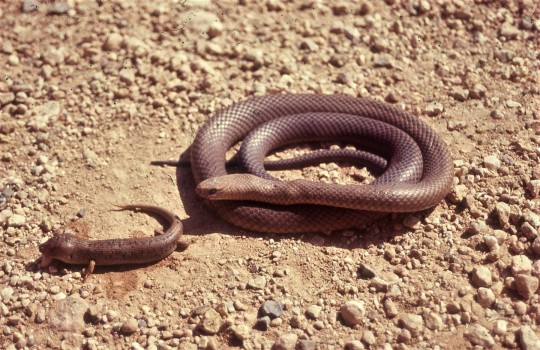
The historic rediscovery of the pygmy bluetongue
(Image credit: Graham Armstrong)
Our previous assumptions of extinction were fortunately premature, but the pygmy bluetongue skink is in serious trouble nonetheless. While they are able to live in a variety of different grassland types, both native and exotic, the extensive modification of their entire distribution through cereal cropping and urbanisation has led to their populations becoming very small and fragmented, giving them a ranking of Endangered on the IUCN Red List. Almost all of these populations are on private land (often grazed by sheep), which makes protecting and/or studying them particularly difficult and complex.
However, when it comes to future threats to the species, climate change is easily the most worrying. As Australia becomes ever hotter and drier, their small remaining distribution is likely to become largely unsuitable, threatening the existence of the entire species. To combat this, researchers are currently investigating the viability of translocating populations further south to areas with cooler climates, providing a safeguard if they do indeed disappear from their remaining natural distribution.
But how do you study a lizard that lives exclusively in small spider holes? Well, if you want to catch them, there's only one tool for the job - the humble fishing rod. Not any special fishing rod either, just a regular rod with a poor mealworm shoddily tied to the end. Using this, you can engage in a tug of war with the lizards until, if they aren't being too difficult, you're able to pull them completely out of their burrow and catch them to perform the necessary measurements and processing. David Attenborough kindly demonstrates this technique in Life in Cold Blood, although in his case the lizard was steadfast in remaining in the burrow!

the sacred tool of the mighty lizard fishermen
returned to their abode
Two additional Fun Pygmy Facts:
Fun Pygmy Fact #1 - The closest living relative of the pygmy bluetongue is the sleepy lizard!
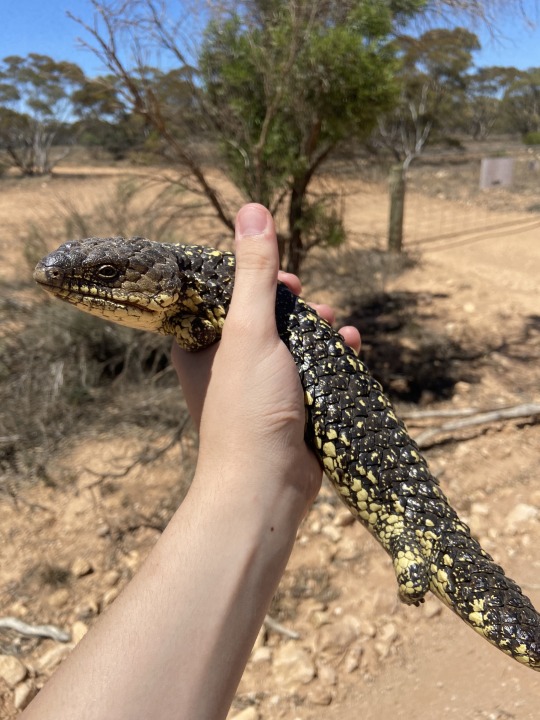
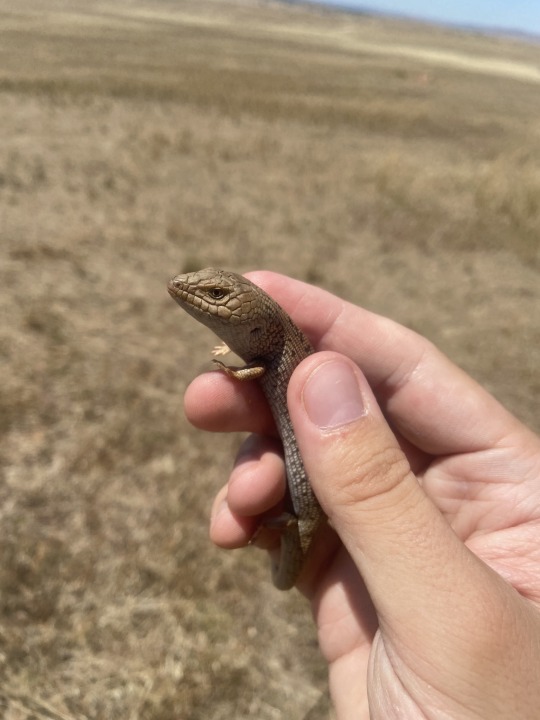
cousins!
Fun Pygmy Fact #2 - Wooden artificial burrows purpose-made for pygmy blueys have proven effective, and the lizards inhabiting them even tend to be in better body condition than those in natural burrows!

#australian wildife#wildlife#reptile#lizard#skink#tiliqua#bluetongue#animal facts#herpetology#natural history#fieldwork#infodumps#my stuff
856 notes
·
View notes
Text
Dc x dp idea 93
Ra forces Talia to sacrifice her son to the ghost king. With his obvious re-awakening he most solidify the deal. It’s how he was gifted the Lazarus water in the first place.
Newley crowned 15 year old Danny did not want this child. Like at all. He’s already dealing with parents who want to tear him apart. That reveal didn’t go well at all.
Danny couldn’t take care of himself let alone a stabby 6 year old. The only good thing is he snatched the kid before he was killed by his scary mom and stinky grandfather.
By ancient law. This child belonged to him. Not only that, the child was bound to obey him. Found that part out on accident. He was tired of the murder attempts and promptly told him to knock that off be quiet and sit down. He’s ashamed to admit it took him at least two hours to realize Damian couldn’t talk or stand up.
Yea.
He’s taken to internal dialogue after that little hiccup. He later learned sign language had no effect. Apparently it had to be verbal. It’s not his say to order anyone around. He doesn’t care what the crown means. They were fine without pariah they’ll be fine without him.
At least while he’s still half alive. Despite what the council says he doesn’t need a legal guardian. He’s perfectly fine homeless.
So here he was with 9 year old child and on the run from the government, his parents, and the royal council.
Now when a man in a trench coat tries to expel the ecto-ghost to free the “boy” and the child. Well. He asked for help.
This leads to a dna test. Danny ignored how he had been told Batman by Damian it was of no help. Danny hadn’t even meant to ask, knowing Damian would be forced to answer. His mother must of lied to the poor thing.
With a shocking result, the father was Bruce Wayne. Bruce Wayne can reclaim his son, but Danny can’t simply hand him over. Something of equal or greater value has to be exchanged.
Obviously Bruce Wayne is happy to make a deal.
Danny just goes. Well either i need a legal guardian as the ghosts are on my butt about it and my parents want me dead. Or. A government organization taken down for trying to eradicate his species.
He gets both.
Damian and Danny refuse to tell anyone why Damian was sacrificed to him.
#danny phantom#danny fenton#dp x dc#dc x dp#dp dc crossover#dp x dc crossover#dp x dc prompt#Damian is sold to Danny#Danny is not here for it#quickly learns to be quiet#he does not want an obedient child#or a routy child#he wants to go to school#and not be on the run#let him have some semblance of normal#sam sends him money#tucker hides his trace#jazz is desperately trying to get emancipation#both Damian and Danny are very fluent in sign language now#damian is still stabby#jazz wasn’t to help with that#sam and tucker are to stressed to find anything about this situation funny#Bruce is gonna be so mad#not only was his son sacrificed#but was bound to obey for all eternity#thankfully it was to someone who didn’t want that#but why was he sacrificed to a child in the first place#ghost king danny
2K notes
·
View notes